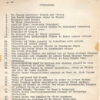calsfoundation@cals.org
Black United Youth (BUY)
Black United Youth (BUY) was a militant, black power–inspired youth organization that grew out of War on Poverty programs in Pulaski County in the mid-to-late 1960s. It had chapters in Little Rock (Pulaski County), North Little Rock (Pulaski County), Arkadelphia (Clark County), and Benton (Saline County).
BUY’s activities in Little Rock are the best documented of all the chapters. BUY’s Little Rock president was Bobby Brown, the younger brother of Minnijean Brown Trickey, one of the Little Rock Nine. BUY was, according to Brown, “an eyeball to eyeball organization” dedicated to “direct confrontation with white people for making changes.” Brown stated that BUY included “schoolteachers [and] professional people” as well as “street people [and] gangsters” from the local neighborhoods among its membership. Within this broad constituency was a common goal of obtaining what African Americans felt was a “fair share” of access to schools, jobs, homes and other community resources. Much of BUY’s early activity revolved around conducting picketing and selective buying campaigns at Kroger Stores to challenge what BUY claimed were its discriminatory hiring policies.
The most publicized episode in BUY’s brief existence was related to the killing of eighteen-year-old Curtis Ingram at the Pulaski County Penal Farm. Ingram was arrested in July 1968 for driving without a driver’s license. Seven prescription pills were found in his possession. He was charged under Arkansas’s drug laws and sent to work off his fine of $110.50 at one dollar a day at the penal farm. On his first full day there, a white trusty (an inmate used as a guard at the jail) killed Ingram. The official version of events was that Ingram had tried to attack the guard. However, BUY member and black radio station KOKY disc jockey Bob Broadwater produced witnesses that said Ingram had been attacked on the orders of a paid guard.
BUY held a rally on Friday, August 10, to protest Ingram’s killing and the conditions at the penal farm. Around 300 protesters marched from Dunbar Community Center to the Pulaski County Courthouse on Markham Street. A heavy police presence, along with mobilized national guardsmen, marshaled the event. As the marchers returned to the black community, several conflicts between marchers and the police broke out. There followed several days of widespread disturbances. Governor Winthrop Rockefeller announced a curfew four nights in a row to try to quell the violence, and he summoned more reinforcements from the National Guard.
BUY, in conjunction with other black community organizations, subsequently and successfully sued for a Pulaski County grand jury that was more representative of the wider community—in particular one that included more than token black representation. This, BUY believed, would lead to a greater responsiveness to the treatment of blacks by the criminal justice system.
BUY was never a stranger to controversy. In March 1969, an inflammatory article titled “Kill or Be Killed” appeared in BUY’s newsletter. Anonymously written, it contained the following: “Brother, get your gun because it will soon be kill or be killed. Let us arm ourselves and join together to stop whitey from misusing us….Don’t continue living under whitey’s suppression.” When the article received media attention, Brown explained that the newsletter was an uncensored black community publication and that the views expressed in it were not necessarily BUY’s views. In April 1969, Brown attended the National Black Economic Development Conference in Detroit, Michigan. He brought back to Arkansas with him the demands of its “Black Manifesto” for white churches and synagogues to pay the black community reparations for slavery. He did not find the clergy in the state to be receptive to these demands.
In June and July 1969, Brown and fellow BUY member James Edward Perkins were involved in a bizarre episode with James Leonard from Sheridan (Grant County) and Leonard’s wife. The Leonards had stolen a cache of weapons in Missouri. When they were caught in Sheridan, they claimed that Brown and other members of BUY had in turn stolen the guns from them. Weapons were found at Brown’s and Perkins’s homes. There was much discussion at the trial about the reliability of the Leonards’ testimony. Eventually, the state’s robbery case against Brown and Perkins collapsed when the Leonards absconded, but Brown and Perkins were still charged with possessing stolen property. According to Brown, the state cut an informal deal with him that involved dropping the charges if Brown agreed to leave Arkansas. He took the deal.
Without its dynamic leader, BUY’s presence apparently faded, and its activities largely disappeared from the public record.
For additional information:
Forman, James. The Making of Black Revolutionaries. Washington DC: Open Hand Publishing, 1985.
Kirk, John A. “An ‘Eyeball-to-Eyeball Kind of Organization’: Black United Youth and the Black Power Movement in Arkansas.” Arkansas Historical Quarterly 75 (Autumn 2016): 206–238.
———. Interview with Bobby Brown, Little Rock, Arkansas, May 10, 1993. Special Collections. University of Arkansas Libraries, Fayetteville, Arkansas.
———. Redefining the Color Line: Black Activism in Little Rock, Arkansas, 1940–1970. Gainesville: University Press of Florida, 2002.
John A. Kirk
University of Arkansas at Little Rock
 Blytheville Boycotts of 1970–1971
Blytheville Boycotts of 1970–1971 Civil Rights Movement (Twentieth Century)
Civil Rights Movement (Twentieth Century) Divergent Prosperity and the Arc of Reform, 1968–2022
Divergent Prosperity and the Arc of Reform, 1968–2022




Comments
No comments on this entry yet.